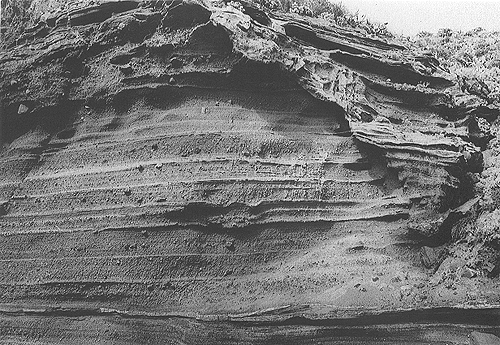
Erosional surfaces: V-shaped channel form
Plate 73

Erosional surfaces: V-shaped channel form
Plate 73
An erosional surface assuming the profile of a channel section is a channel form. I avoid the term "channel" without specifications for the following reasons: 1) the geometry of a channel is not always recognizable in stratigraphic sections; for instance, the longitudinal profile can be parallel to bedding with no apparent truncations, and the transversal section is also bed-parallel or complex in case of lateral migration or abrupt shifting (avulsion); 2) channel-looking profiles, on the other hand, can be simple ephemeral scours made by non channeled flows. Scours do not contain the flow that produces them, whereas channels do. A single, unconfined flow can simultaneously produce several scours along its base. Furthermore, a channel is a geomorphic and hydraulic unit: except in extreme climatic conditions, it represents a relatively stable element of the landscape and conveys many flows before being abandoned.
In this and in plates 74 and 75, we are going to examine some channel forms displayed by pyroclastic deposits in the Salina islands, Eolian archipelago.
The cliff seen in plate 73 is about 6 m tall, and shows fall deposits of various sizes in distinct parallel beds. The beds are cut by a V-shaped surface, complicated by steps and small terraces. The lower part of the V is filled by deposits similar to the surrounding ones; they are bedded, with a slight inclination. Thin-bedded ash constitutes the upper and widest portion of the fill, and drapes over the shoulders of the V thus "sealing" it. The outcrop is covered by weathered crusts along a flank of the V.
Water running down a steep slope incised this erosional form, which can be called a gully, rill, or arroyo: vertical erosion (entrenchment) was favored by the loose state of the materials. Water-carried, reworked pyroclastics were abandoned on the bottom of the V. The rest of the section remained open for a while, until a hot, surge-type flow arrived with a suspended load of fine ash. The ash was deposited in both parallel and cross-bedded units, with a broad concave-up attitude and a meniscus-like contact with the V profile.
This channel form is interpretable as a true channel because: 1) it is not synchronous but was created in several steps; 2) it served for different processes; and 3) was filled by many depositional events. There is no evidence of lateral migration.
Other (not erosional) features visible in the outcrop are the isolated wavelike form (dunoid) near the bottom, with the light band marking a drape of fine ash, two adjacent pits left by the landing of volcanic bombs on another bed of fine ash (near the center of the picture: compare with plate 121), and some vertical structures due to escaping of hot gas (gas pipes) in overlying beds.
Pleistocene pyroclastics, Salina island, Tyrrhenian Sea.